 |
Camp Tonkawa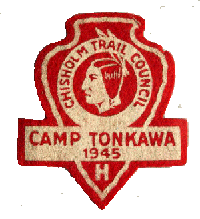 The
first camp of the Chisholm Trail Council, then known
as the Abilene Council,
was held in 1925 on the Baptist Encampment grounds at
Christoval, Texas.
This same site had been used by two other councils for
a summer camp, Concho
Valley Council and Buffalo Trail Council. The
camp was ten-days long
and had some seventy to eighty boys attend. One
of the highlights
of this camp was a ceremony in which the first Eagle
Scout badge was presented
to an Abilene Council Scout. He was Eugene
Surface, the son of Dr.
E. B. Surface, who was pastor of the Central
Presbyterian Church in Abilene.
The Scouts rode a booster train from San Angelo back
to Abilene.
They formed a parade at every town they stopped at on
the way home. The
first camp of the Chisholm Trail Council, then known
as the Abilene Council,
was held in 1925 on the Baptist Encampment grounds at
Christoval, Texas.
This same site had been used by two other councils for
a summer camp, Concho
Valley Council and Buffalo Trail Council. The
camp was ten-days long
and had some seventy to eighty boys attend. One
of the highlights
of this camp was a ceremony in which the first Eagle
Scout badge was presented
to an Abilene Council Scout. He was Eugene
Surface, the son of Dr.
E. B. Surface, who was pastor of the Central
Presbyterian Church in Abilene.
The Scouts rode a booster train from San Angelo back
to Abilene.
They formed a parade at every town they stopped at on
the way home.
This became Camp Tonkawa, located in Buffalo Gap some sixteen miles south of Abilene, TX, and is now owned by the Texas Trails Council, BSA, formerly Chisholm Trail Council, BSA. This camp was established in 1929 and is now celebrating its 75th Anniversary.
Old
Trading Post
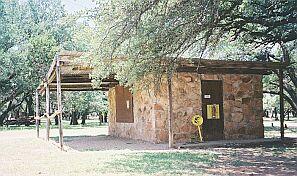 Credit
for the idea of founding Camp Tonkawa must go to Judge
C. M. Caldwell.
He and Ed Shumway secured a lease from the City of
Abilene to a small five
acres plot near the State Park at Buffalo Gap,
TX. The land was leased
in May, 1929 but soon proved too small, so in 1936
they added another fifty
acres of land for a total of fifty-five acres for the
camp. By 1949
that was increased to ninety-six acres.
They found out, when
they wanted a ninety-nine year lease on the land, that
the city had actually
leased the land to the State of Texas for a
park. The State of Texas
could not give a ninety-nine year lease until after
1970, which was the
date which the bonded indebtedness against Lake
Abilene was completely
paid. They did, however, give them a twenty-five
year lease on the
land. Credit
for the idea of founding Camp Tonkawa must go to Judge
C. M. Caldwell.
He and Ed Shumway secured a lease from the City of
Abilene to a small five
acres plot near the State Park at Buffalo Gap,
TX. The land was leased
in May, 1929 but soon proved too small, so in 1936
they added another fifty
acres of land for a total of fifty-five acres for the
camp. By 1949
that was increased to ninety-six acres.
They found out, when
they wanted a ninety-nine year lease on the land, that
the city had actually
leased the land to the State of Texas for a
park. The State of Texas
could not give a ninety-nine year lease until after
1970, which was the
date which the bonded indebtedness against Lake
Abilene was completely
paid. They did, however, give them a twenty-five
year lease on the
land.
Once they had the land they had to build campsites on it and build permanent buildings on the land. Those improvements came very slowly as the Council did not have that kind of money in their budget. Summer Camp In 1929A dirt dam was built across Elm Creek and the area where the dirt was taken out became the swimming pool. The banks of the swimming pool and the bottom of the pool were very muddy. The drinking water was hauled in on a wagon. A man from Buffalo Gap used two tanks for this purpose. He kept one at camp and used the other one to haul the water and fill the tank at camp. The water was from open stock tanks and was untreated. Log Cabin The
boys started the building of a log cabin and was
located about 100 yards
north of the mess hall. The only time any work
was done on the cabin
was during summer camp. It was never completed
and only needed a
roof to be usable. It was removed in 1942 by
unknown parties. The
boys started the building of a log cabin and was
located about 100 yards
north of the mess hall. The only time any work
was done on the cabin
was during summer camp. It was never completed
and only needed a
roof to be usable. It was removed in 1942 by
unknown parties.
Totem Pole
 The summer
camp in 1931 was the same as in 1930 with no
improvements made to the camp
facilities. Red Cross life saving classes were
taught in the dirt
pool. By 1932 they had decided to not use the
pool at camp.
Instead, using buses, they took the Scouts to the
swimming pool at the
Presbyterian Encampment grounds. A water well
was dug about twenty
steps east of the log cabin and was used for
drinking. The water
had to be drawn out of the well with a bucket. The summer
camp in 1931 was the same as in 1930 with no
improvements made to the camp
facilities. Red Cross life saving classes were
taught in the dirt
pool. By 1932 they had decided to not use the
pool at camp.
Instead, using buses, they took the Scouts to the
swimming pool at the
Presbyterian Encampment grounds. A water well
was dug about twenty
steps east of the log cabin and was used for
drinking. The water
had to be drawn out of the well with a bucket.
A commissary was built between the mess hall and the new well. It was a ten foot square building open on three sides. They sold ice cold drinks, candy and handicraft items out of this new facility. It was dismantled in 1930 and a new one was opened in the south-west corner of the mess hall. By the summer of 1934 the Scouts went to the State Park swimming pool for a charge of ten cents per day per Scout. The C.C. C. boys were stationed in barracks at the State Park. They moved away early in 1935 and arrangements were made for that summer camp to be held in their buildings at the State Park. The following year they moved back to Camp Tonkawa and dug a new water well which provided the camp with their water for the next couple of years. Very few changes in the physical equipment was made at the camp over the next several years. The well went dry and they were forced to dig yet another well which was considered very weak but is still producing water today. In 1938 they put a concrete floor in the mess hall and screened it in. They also added a few dishes to the kitchen. All during this time Ed Shumway was the camp director and his wife served as nurse. Totem PoleNo Camps From 1939 - 1942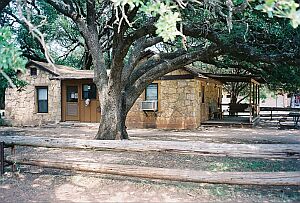 There
was no summer camps held at Camp Tonkawa from 1939
through 1942.
It was in 1938 that the Executive Board of the council
had trouble in removing
Ed Shumway from the position of Scout Executive and
employing Laverne Haugness
as his replacement. Haugness was in opposition
to the camp program
and allowed the camp property to deteriorate and the
grounds to become
overgrown with shrubs and brush. It was during
this time that the
log cabin was removed and kitchen equipment
stolen. The public had
been cutting the cedar trees on the property for
Christmas trees. There
was no summer camps held at Camp Tonkawa from 1939
through 1942.
It was in 1938 that the Executive Board of the council
had trouble in removing
Ed Shumway from the position of Scout Executive and
employing Laverne Haugness
as his replacement. Haugness was in opposition
to the camp program
and allowed the camp property to deteriorate and the
grounds to become
overgrown with shrubs and brush. It was during
this time that the
log cabin was removed and kitchen equipment
stolen. The public had
been cutting the cedar trees on the property for
Christmas trees.
The board employed a camp caretaker in early 1943 by the name of W. W. Faulkenberry and he got the camp ready to open again that summer. He lived in a room in the corner of the mess hall. Camp Barkeley furnished the camp with serving dishes and the boys furnished their own mess kits. By the summer of 1943, a two room rock house was built for the caretaker at a cost of $700. The cook for the 1943 summer camp was a man by the name of Howard. He was a great cook and always insisted on working by himself. He could cook for a few people or two hundred and serve every meal on time. One Sunday afternoon in 1946 about two hundred people were registered for the evening meal. Howard did not show up at camp to prepare the meal so several men went to Abilene to see about him. There they found him too drunk to sober up. A group of scout leaders, under the direction of Mrs. Paul Ireland, had to prepare the meal for that night, the next morning, and lunch that day. They went out in search of a new cook but none could be found. Therefore, Howard was kept on until the end of the season and that was all for him at Camp Tonkawa. Swimming
Pool
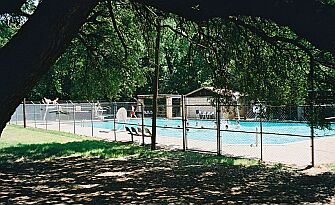 By
that same summer they had built a new swimming pool, a
new hot water system,
dish washing system, butane gas for cooking, a new
handicraft and headquarters
lodge, a newly painted mess hall, eight new troop
campsites and a new obstacle
training course. By
that same summer they had built a new swimming pool, a
new hot water system,
dish washing system, butane gas for cooking, a new
handicraft and headquarters
lodge, a newly painted mess hall, eight new troop
campsites and a new obstacle
training course.
By 1949 the camping program was converted from a mass camp to a troop camp. Instead of boys coming to camp and being look after by just the camp director, they now came to camp with their troop under a troop leader. All troop leaders were advised in advance that, if a boy planned to attend camp, he must come in a troop and each troop must have a least one adult leader. It took a couple of years for this new way of camping to catch on but has proven to be the best method of camp operation and is still used at the camp today. By 1951 a rifle range and Archery range was added to the camp program.
Mural
Inside Dining Hall
The lake was developed in 1957. Fred Swan of the Caterpillar Tractor Company took on the job of using one of his largest dozers and an employee to clear the area of trees in preparation of building the lake. They discovered that there was too much sand below the topsoil and that the lake may not hold water. With the help of several producing oil companies donating drilling mud to line the new lake they were able to seal the bottom so it would hold water. Everything
went well until
they started bulldozing for the base of the
dam. All of a sudden
the bulldozer started sinking in quick sand.
They had to make a quick
call into Abilene to get the largest piece of
equipment available to rescue
the dozier. Shortly after the dam was
completed a good rain
came and filled up the lake. Since the lake
has been built it has
filled up with silt and is now very shallow.
Training
Center
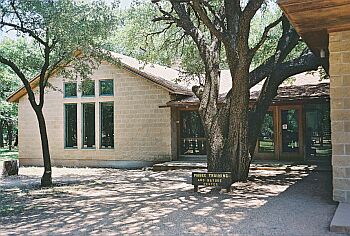 The
Camp Ranger's residence is a former barracks building
at the Stamford,
Texas Air Field during World War II. It was used
as a Scout meeting
place in Avoca for several years having been donated
by Mr. and Mrs. R.
T. Taylor of that city. Later, after the
troop had been disbanded,
the building was donated to the council and remodeled
into a nice residence
for the Camp Ranger and his family. The moving of the
building and remodel
work was done in about 1962. Present Camp Ranger
is Chris Wallace,
who officially came on the job on March 1, 2006 The
Camp Ranger's residence is a former barracks building
at the Stamford,
Texas Air Field during World War II. It was used
as a Scout meeting
place in Avoca for several years having been donated
by Mr. and Mrs. R.
T. Taylor of that city. Later, after the
troop had been disbanded,
the building was donated to the council and remodeled
into a nice residence
for the Camp Ranger and his family. The moving of the
building and remodel
work was done in about 1962. Present Camp Ranger
is Chris Wallace,
who officially came on the job on March 1, 2006
In about 1994 a new COPE Course was built which had proved to be one of the highlights of the summer camp program. A COPE Course is a ropes course with both a low course and a high course designed to give boys a challenge to see how good they were in problem solving and using skills sometimes twenty feet off the ground. A new training facility and camp office was completed in 1995 The camp continues to serve the needs of the Scouts in the Chisholm Trail Council. The Texas Parks and Wildlife Commission, May 28, 2009, approved the transfer of 91.3 acres of Abilene State Park property to the Texas Trails Council, which had been leasing the land from the State for 60 years. The first lease was started on June 7, 1949 and was to last for 19 year. It was renewed for 50 years and was due to expire in 2018. The Texas Parks and Wildlife Department retained a conservation easement on the land and also the state stipulated that if the property was ever used for anything other than a Boy Scout Camp, the land would revert to the Texas Parks and Wildlife ownership. One week
of summer camp was held at Camp Tonkawa June 27
through July 3, 2010 during the 100th
Anniversary of Scouting. Camp
Tonkawa is now a Cub Scout camp with Scout summer
camp being held at Camp Billy Gibbons. |
Click
here for more photos of Camp Tonkawa | Henry
McGinty Story About Camp Tonkawa | Information for this page was gathered from "History of the Chisholm Trail Council Boy Scouts of America", by Claude "Skipper" Willis, August 1952, and "Chisholm Trail Council Boy Scouts of America, 1954 - 1969", by Henry H. McGinty, June 1, 1997. Last
updated: September 25, 2020
|
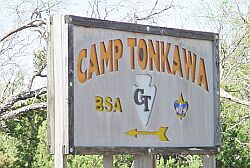 The
council was unable to put together a camp in 1926
because John Price took
two buses of Boy Scouts to Philadelphia that
summer. It was felt
that Christoval was too far away from Abilene to
have another camp there,
so in 1927, they went to the Baptist Encampment
grounds at Lueders, and
was the first camp sponsored by the new Chisholm
Trail Council. They
almost didn't have camp back there in 1928, because
of a water shortage.
But, Ralph Harper, an Eagle Scout, borrowed a water
tank and wagon from
a man at Lueders and hauled water from Abilene so
they could have camp.
The 1927 and 1928 camps were under the leadership of
the new Chisholm Trail
Council.
The
council was unable to put together a camp in 1926
because John Price took
two buses of Boy Scouts to Philadelphia that
summer. It was felt
that Christoval was too far away from Abilene to
have another camp there,
so in 1927, they went to the Baptist Encampment
grounds at Lueders, and
was the first camp sponsored by the new Chisholm
Trail Council. They
almost didn't have camp back there in 1928, because
of a water shortage.
But, Ralph Harper, an Eagle Scout, borrowed a water
tank and wagon from
a man at Lueders and hauled water from Abilene so
they could have camp.
The 1927 and 1928 camps were under the leadership of
the new Chisholm Trail
Council.
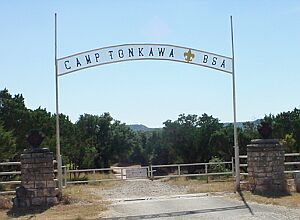 In
1929, the camp was held at the Presbyterian
Encampment Grounds at Buffalo
Gap with eighty-five boys for a ten-day period,
which was very common in
the early days of Scouting. A boy went to camp
for the sum of $6,
or he could stay for two weeks for only
$11. According to a
thesis written by Claude Glen Willis in 1952, "No
leaders were required
to be with the boys during their stay in camp.
This was mass camping
with the camp director looking after all the
boys. The camp program
consisted of swimming, life saving, first aid,
hiking, mountain climbing,
Scout craft, and group singing. There was a
campfire program and
Court of Honor on each Monday night. One
feature attraction for this
camp was the all day hike in which every member of
the camp participated.
There was no one in camp on this hike day and the
noon meal was eaten out
on the hike."
In
1929, the camp was held at the Presbyterian
Encampment Grounds at Buffalo
Gap with eighty-five boys for a ten-day period,
which was very common in
the early days of Scouting. A boy went to camp
for the sum of $6,
or he could stay for two weeks for only
$11. According to a
thesis written by Claude Glen Willis in 1952, "No
leaders were required
to be with the boys during their stay in camp.
This was mass camping
with the camp director looking after all the
boys. The camp program
consisted of swimming, life saving, first aid,
hiking, mountain climbing,
Scout craft, and group singing. There was a
campfire program and
Court of Honor on each Monday night. One
feature attraction for this
camp was the all day hike in which every member of
the camp participated.
There was no one in camp on this hike day and the
noon meal was eaten out
on the hike."
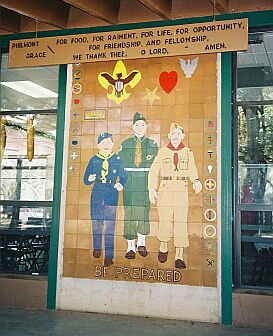 A
new dining hall was built in 1957-58 and completely
remodeled in 1996.
The old dining hall, later called the Recreation
building and Quartermaster
building, was built in the early thirties on the
edge of Elm Creek.
It was still a good building but needed some major
repair work done on
it. They jacked up the roof, removed the
rotten sills and cut the
studs off at about 3 feet from the floor, and then
built a cement block
wall about three feet high, installed new sills and
lowered the building
back onto the cement block wall. In 1962 the
Kiwanis Club of Abilene
donated $500 and a new galvanized steel roof was
added to the old building.
It is still in use today.
A
new dining hall was built in 1957-58 and completely
remodeled in 1996.
The old dining hall, later called the Recreation
building and Quartermaster
building, was built in the early thirties on the
edge of Elm Creek.
It was still a good building but needed some major
repair work done on
it. They jacked up the roof, removed the
rotten sills and cut the
studs off at about 3 feet from the floor, and then
built a cement block
wall about three feet high, installed new sills and
lowered the building
back onto the cement block wall. In 1962 the
Kiwanis Club of Abilene
donated $500 and a new galvanized steel roof was
added to the old building.
It is still in use today.